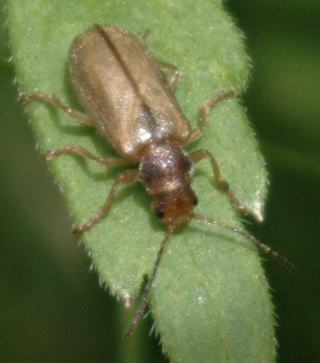
Picea abies, the Norway spruce or European spruce, is a species of spruce native to Northern, Central and Eastern Europe.

The Fraser fir is a species of fir native to the Appalachian Mountains of the Southeastern United States.

The Synetinae are a small subfamily within the leaf beetle family (Chrysomelidae). They are found entirely within the Holarctic, mainly in North America but also appearing in parts of Europe and Asia. The subfamily contains only two genera, Syneta and Thricolema, with a total of 12 described species. The group is sometimes treated as a tribe of Eumolpinae, where they are known as Synetini.

Zeiraphera canadensis, the spruce bud moth, is a moth of the family Tortricidae. It is a small brown moth mainly found in North America, specifically New Brunswick, Quebec, and the north-eastern United States. The adult moth flutters quickly, and stays low among trees during the day and higher above tree cover after sunset. The spruce bud moth relies primarily on the white spruce tree as a host plant. Both male and female spruce bud moths mate multiply, however males have the ability to secrete accessory gland proteins that prevent female re-mating. The moth is univoltine, meaning only one generation hatches per year, and its eggs overwinter from July to May. The species Z. ratzeburgiana is very similar to Z. canadensis and can only be distinguished by the presence of an anal comb in Z. canadensis.

Syneta is a genus of leaf beetles in the subfamily Synetinae. There are about 11 described species in Syneta. The genus is entirely holarctic in distribution, with species appearing in North America, Siberia, East Asia and Northern Europe.

Phratora is a genus of leaf beetles. It is synonymous to Phyllodecta . European Phratora species can be distinguished based on morphology of female genitalia., but they differ little in size and body form and most show metallic coloration.
Choristoneura biennis, the two-year-cycle budworm moth, is a species of moth of the family Tortricidae. It is found in Canada, where it has been recorded from Alberta and British Columbia.
Syneta ferruginea, the rusty leaf beetle, is a species of leaf beetle. It is found in eastern North America.

Tetropium is a genus of long-horned beetles in the family Cerambycidae. There are at least 20 described species in Tetropium.
Xyloterinus is a genus of typical bark beetles in the family Curculionidae. This is a monotypic genus and the one described species is Xyloterinus politus. It is native to North America where it infests both hardwood and softwood trees, as well as stacks of logs.
Phratora americana is a species of leaf beetle in the family Chrysomelidae. It is found in North America.This species is known from Ontario, Quebec, and high elevations in the eastern United States of America. It feeds on willow species and varies in color from purple to blue or blue-green.

Tegrodera is a genus beetles known as iron cross blister beetles and iron cross soldier beetles. They are in the family Meloidae. There are at least three described species in Tegrodera.
Syneta simplex is a species of leaf beetle found in North America. The species includes the two subspecies Syneta simplex simplex, which lives at elevations considerably below timberline and feeds on Garry oak, and Syneta simplex subalpina, which is found near timberline in Washington and British Columbia and feeds on alpine fir.
Phratora interstitialis is a species of leaf beetle in the family Chrysomelidae. It is found in Europe and Northern Asia and North America. This leaf beetle feeds on host plants that are poor in salicylates and is closely related to the European Phratora vulgatissima, which also feeds on salicylate-poor willows.
Syneta seriata is a species of leaf beetle. It is found in North America. It feeds on California live oak and California black oak.

Zarhipis is a genus of glowworm beetles in the family Phengodidae. There are at least three described species in Zarhipis, all restricted to the western regions of North America.
Phratora hudsonia, the birch leaf beetle, is a species of leaf beetle in the family Chrysomelidae. It is found in North America. This species is known from Canadian populations at the Great Slave Lake and north shore of Lake Superior. It feeds on birch and is metallic brown in color. It is relatively small in size, like other Phratora species.
Syneta pilosa is a species of leaf beetle. It is found in North America.

Phratora purpurea, the aspen skeletonizer, is a species of leaf beetle in the family Chrysomelidae. It is found across North America, including Maryland, New York, Ontario, British Columbia, and the Northwest Territories. It feeds on willows and poplars, and is deep purple or coppery red in color.
Elatobium abietinum, commonly known as the spruce aphid or green spruce aphid, is a species of aphid in the subfamily Aphidinae that feeds on spruce, and occasionally fir. It is native to Northern, Central and Eastern Europe and has spread to Western Europe, North America and elsewhere.








